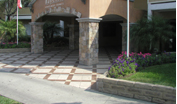
www.cptedsecurity.com
From Blight to Bright
11/10/05
By: Harry Erickson
|
|
 |
|
 |
 |
 |
|
Historically, a great deal of emphasis has been placed on “target hardening” when considering security. Locks, security screen doors, solid fences and security patrols all play important roles in preventing crime. Recently, there has been a re-emergence of Crime Prevention Through Environmental Design, or CPTED, which utilizes physical design features to augment physical security and reduce the fear of crime. CPTED is an important component in any security plan. A third, and emerging, crime prevention technique is “Public Art.” Public Art is artistic pieces such as murals, sculptures and decorative facades which enhance the physical appearance of the environment and celebrate the unique characteristics and identity of a community. Public Art can also reduce crime and instill a sense of pride and “ownership” with the residents of a community. It is important for neighborhoods to have a positive identity and self image. Too often, blighted and high-crime areas focus on target hardening which can project a negative image. The best crime deterrent is a neighborhood which projects the image that the people care and will not tolerate criminal behavior. Criminals are discouraged from operating in areas which gives them the feeling that someone will challenge them and turn them in. Public Art and CPTED can help you achieve this goal. There are various ways to incorporate Public Art into the physical elements of a community with crime prevention in mind. One such way is to use it to discourage graffiti. Graffiti is a major problem throughout our cities and is a driving force in the decline of neighborhoods. A wall or the side of a building which is littered with graffiti gives residents and visitors the feeling of fear, loss of control and depression. Many neighborhoods have had success in preventing graffiti in problem areas through the use of Public Art murals. Local artists and residents are bought together to design the mural which reflects the culture, traditions and history of the residents. The youth and adults of the community work together in the planning and painting process, to ensure that the mural reflects the entire community and not just one segment. At the conclusion a maintenance committee is formed to keep the mural in good condition. Utility boxes are another favorite of graffiti vandals. Many communities have worked with local artists and residents to paint the boxes with colorful designs which, not only deter graffiti, but also brighten up the area. Another form of Public Art, which fosters positive feelings about a community is the painting of architectural facades which add beauty to otherwise plain buildings. These are very unique murals in that they look 3 dimensional and give the impression of additional windows, stone corner columns and landscape features on a flat surface building. These types of projects foster pride in the residents of neighborhoods and add an overall feeling of “richness” to the structures. Another option is a series of Public Art sculptures placed throughout a neighborhood, which can help set it apart from others, resulting in community pride as well. By incorporating decorative Public Art features into buildings and streetscapes you can reduce blight and give residents a much needed boost in the pride they have in their neighborhood. This in turn, will create a feeling of ownership, resulting in the residents taking a more active role in keeping their neighborhood clean and safe. A community which incorporates the right mixture of locks, CPTED and Public Art will enjoy long term success in their efforts to create a more peaceful place to live.
|
© CPTED Security 2005